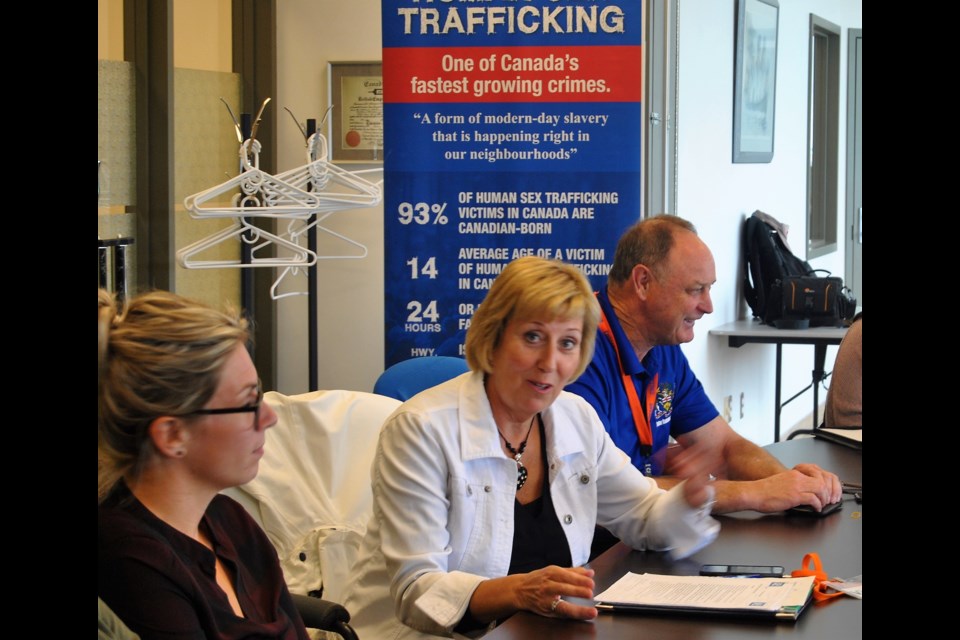Laurie Scott MPP for Haliburton – Kawartha Lakes- Brock, in Timmins for the Progressive Conservative Party of Ontario’s caucus meeting this weekend, took the time to participate in a roundtable on human trafficking in Ontario, which she described as growing at alarming rate.
Participants in the round table included Timmins police services, Timmins and Area Women in Crisis and Mayor Steve Black.
Earlier this year the Ontario Ministry of Community Safety and Correctional Services introduced Ontario’s strategy for eliminating human trafficking, but Scott said more must be done to put an end to human trafficking.
“Putting an end to human sex trafficking has been passionate piece of policy that I have been working on at Queen’s Park for the last several years,” Scott said.
Scott, the PC’s Women’s Issue critic has introduced a couple of private members bills to tackle the human trafficking problem in Ontario.
“I want to discuss the problem of human sex trafficking in Timmins, and get some feed back on what we at Queen’s Park should be doing to help eliminate this growing problem,” she added.
Laurie Scott has been working on the issue for three years.
“My first motion was for Ontario to institute a multi-disciplinary task force that would coordinate the efforts of police, the justice system, victim’s services,” explained Scott.
Scott then introduced another private members’ bill she called “Saving the Girl Next Door,” which was passed by the Ontario Legislature.
“Public awareness and education is a big part of this and I am making more and more communities aware of this problem,” Scott said.
In one of her statements on the issue that she released on World Day against Trafficking in Persons, held each year on July 30, Scott indicated that Ontario is home to the largest number of human trafficking cases in Canada.
“Human trafficking has become one of the fastest growing and most lucrative criminal enterprises in Canada, where 90 per cent of the victims are born and raised in Canada,” Scott said.
Scott stated human sex trafficking forces men, women and children into exploitative situations, dehumanizing and robbing victims of their dignity by allowing them to be bought, sold, or rented. In short, trafficking provides an avenue for abuse and violence.
“While human trafficking impacts people of all backgrounds, this issue disproportionately impacts women and youth,” Scott pointed out.
“We need more awareness, more education, more training and more determination to recognize – and prevent – what is happening right in front of our eyes through the internet and other venues,” she said.
Scott said that a report from the Ontario Select Committee on Violence and Sexual Harassment of Women revealed that the province is a hub for human trafficking in Canada – 65 per cent of all human trafficking in Canada takes place in Ontario.
“It exists in all parts of Ontario, including North Eastern Ontario,” said Scott.
“It’s a form of modern slavery – a crime that involves the recruitment, transportation, harbouring and controlling of a person for sexual exploitation or slavery. The person doesn’t enter it voluntarily.
A lot of it is what Scott termed the “Romeo effect”. Many young people are lured over the internet.
“Young people put everything over the internet that leaves them open to manipulation – I broke up with my boyfriend, my parents aren’t treating me well,” explained Scott.
“Usually, it is an older person who will say your life can be better, I will be your boyfriend, and then later it is payback - the person says you owe for all of this and they are forced into sexual exploitation.”
They call it the “Game” and pimps and traffickers have many girls or a stable.
Officer Lorne Yee representing the Timmins Police Services said there have been a few cases of human trafficking in Timmins
“What is difficult is getting people who are being trafficked to come out and leave and ask for help,” said Officer Yee
What’s staggering is that 90 per cent of the people being trafficked are Canadian citizens and not the foreign women who are brought in from overseas – they only comprise seven per cent of those trafficked in Canada,” said Scott. “It really is the girl next door and it can happen in any community across Canada.”
The internet is playing an increasing role in human trafficking, but Scott also said recruitment takes place near schools or the mall.
“The pimps can quickly determine which girl looks needy, doesn’t have money or is unhappy,” said Scott.
According to the participants in the round table adding human trafficking in the school curriculum is an important weapon as it teaches young people how to recognize it at its earliest stages and they will understand it is not normal and shouldn’t be happening to them.
“It looks very different when they come to us in the shelters, they have been entrenched in the lifestyle for so long and when it is normalized and what that looks like,” said Julie DeMarchi of Timmins and Area Women in Crisis.
“In Timmins, up on the James Bay Coast it looks more like exploitation,“ said DeMarchi. “So many people will say that doesn’t happen here, but it does because exploitation is part of human trafficking.
“Also, women might have addictions that they need to satisfy and they will do anything that is asked of them to survive in the moment, “DeMarchi explained. “This becomes their life the only one they know.”
“The rate of women escaping these relations is quite rampant,” said DeMarchi.
DeMarchi said two thirds of the victims from human trafficking are non-indigenous, and one third are indigenous.
Earlier this year the Ontario government introduced a Strategy to End Human Trafficking
The strategy includes a fund to help Indigenous survivors
